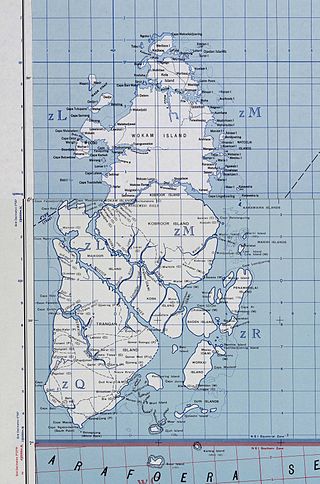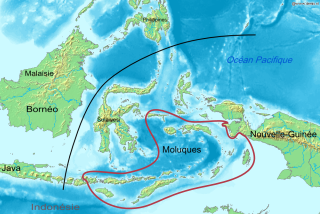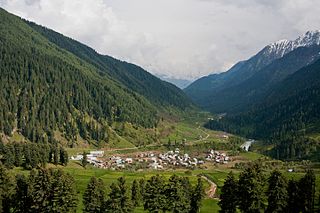Related Research Articles

The Aru Islands Regency is a group of about 95 low-lying islands in the Maluku Islands of eastern Indonesia. It also forms a regency of Maluku Province, with a land area of 6,426.77 km2 (2,481.39 sq mi). At the 2011 Census the Regency had a population of 84,138; the 2020 Census produced a total of 102,237, and the official estimate as at mid 2022 was 103,860. Some sources regard the archipelago as part of Asia, while others regard it as part of Melanesia.
The Cahuapanan languages are a language family spoken in the Amazon basin of northern Peru. They include two languages, Chayahuita and Jebero, which are spoken by more than 11,300 people. Chayahuita is spoken by most of that number, but Jebero is almost extinct.

The Central Malayo-Polynesian languages (CMP) are a proposed branch in the Malayo-Polynesian subgroup of the Austronesian language family. The languages are spoken in the Lesser Sunda and Maluku Islands of the Banda Sea, in an area corresponding closely to the Indonesian provinces of East Nusa Tenggara and Maluku and the nation of East Timor, but with the Bima language extending to the eastern half of Sumbawa Island in the province of West Nusa Tenggara and the Sula languages of the Sula archipelago in the southwest corner of the province of North Maluku. The principal islands in this region are Sumbawa, Sumba, Flores, Timor, Buru, and Seram. The numerically most important languages are Bima, Manggarai of western Flores, Uab Meto of West Timor, and Tetum, the national language of East Timor.
Lola is an Austronesian language spoken on the Aru Islands of eastern Indonesia.

The long-nosed echymipera, or long-nosed spiny bandicoot, is a species of marsupial in the family Peramelidae. It is found in Australia, Indonesia, and Papua New Guinea. Its natural habitat is subtropical or tropical dry forests.
Omi is a Central Sudanic language, spoken in the Aru Territory, Orientale Province, Democratic Republic of the Congo, between the two rivers Nzoro and Lowa. It was once considered a dialect of the Keliko language, but requires separate literature.
The Aru languages are a group of a dozen Austronesian languages spoken on the Aru Islands in Indonesia. None are spoken by more than ten thousand people. Although geographically close to Central Maluku languages, they are not part of that group linguistically.
Kei is an Austronesian language spoken in a small region of the Moluccas, a province of Indonesia.
Barakai is one of the Aru languages, spoken by inhabitants of the Aru Islands.

Aru is a village, tourist spot in the Anantnag District of Jammu and Kashmir, India. It lies 53km from Anantnag city, the district headquarter. It is located around 12 km from Pahalgam, 11 km upstream from the Lidder River. Noted for its scenic meadows, lakes and mountains, it is a base camp for trekking to the Kolhoi Glacier, Tarsar Lake, Marsar and Herbaghwan Lake. The village lies on the left bank of the Aru river, which is a tributary of the Lidder river. Jammu & Kashmir’s biggest Fodder Seed Product Station is also located in the Aru village.

West Ambae is an Oceanic language spoken on Ambae, Vanuatu. Recognized dialects of West Ambae include Walaha and Nduindui (Duindui). The New Testament was published in West Ambae in 1984.
Manombai is one of the Aru languages, spoken by inhabitants of the Aru Islands, Indonesia.
Dobel, or Kobro’or, is one of the Aru languages, spoken by inhabitants of the Aru Islands Regency. It is close to Kola.
Kola is one of the Aru languages, spoken by inhabitants of the Aru Islands.
Tarangan is one of the Aru languages, spoken by inhabitants of the Aru Islands in eastern Indonesia. There are two varieties of Tarangan: East and West Tarangan. These varieties are divergent, perhaps no closer than they are to Manombai, also spoken in the Arus. West Tarangan is a trade language of the southern islands.
Batuley is a language spoken on the Aru Islands of eastern Indonesia. It is close to Mariri; Hughes (1987) estimates that around 80% of lexical items are shared. The language's name comes from the Gwatle island, which the Batuley consider their homeland.
Karey (Krei) is an Austronesian language spoken on the Aru Islands of eastern Indonesia.
Koba is a language spoken on the Aru Islands of eastern Indonesia. It is close to Dobel, though mutual comprehension is low.
Lorang is an Austronesian language of the Aru Islands in eastern Indonesia. It is spoken in one village on Koba Island.
Mariri (Mairiri) is an Austronesian language spoken on the Aru Islands of eastern Indonesia. It is close to Batuley.
References
- ↑ Ujir at Ethnologue (18th ed., 2015) (subscription required)
- ↑ Schapper, Antoinette (2015). "Neuter gender in the languages of Aru". Wacana. 16: 1–26. doi:10.17510/wjhi.v16i1.364. S2CID 145126612.